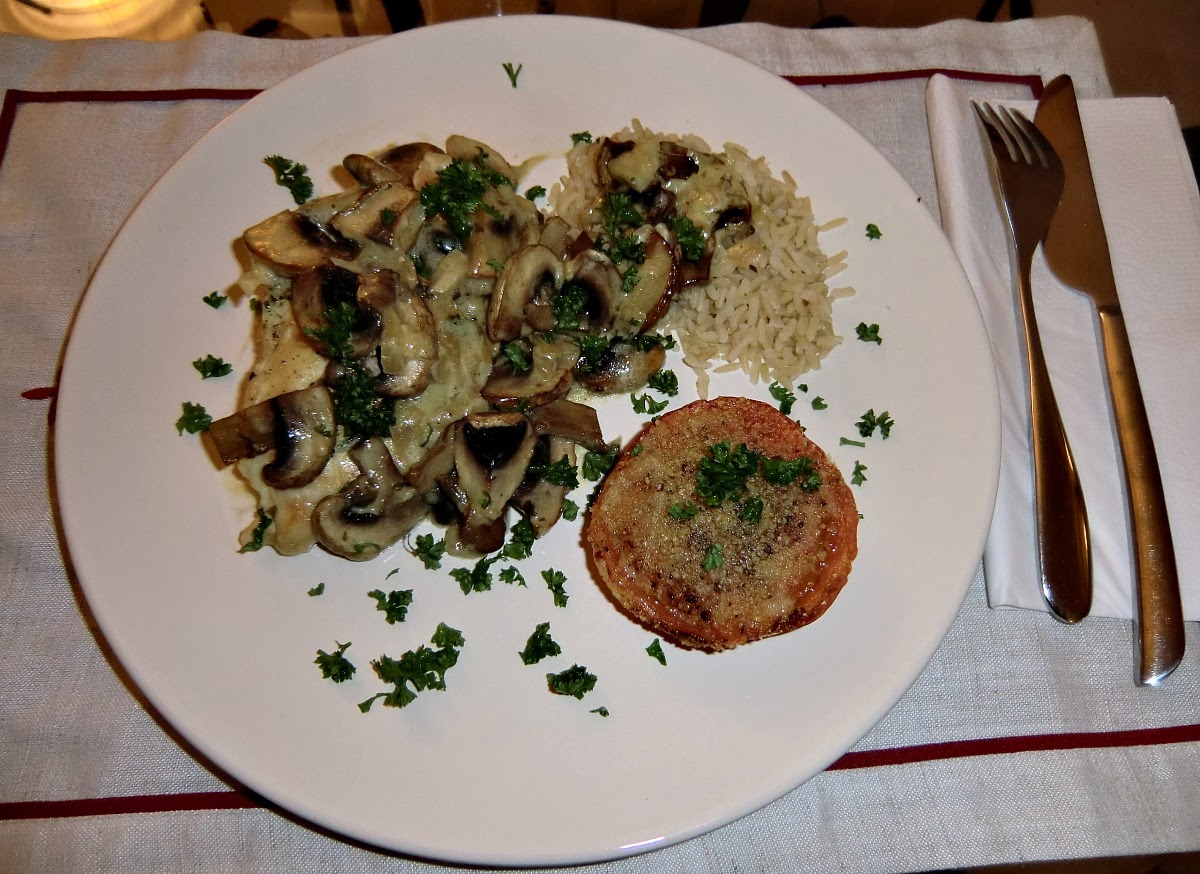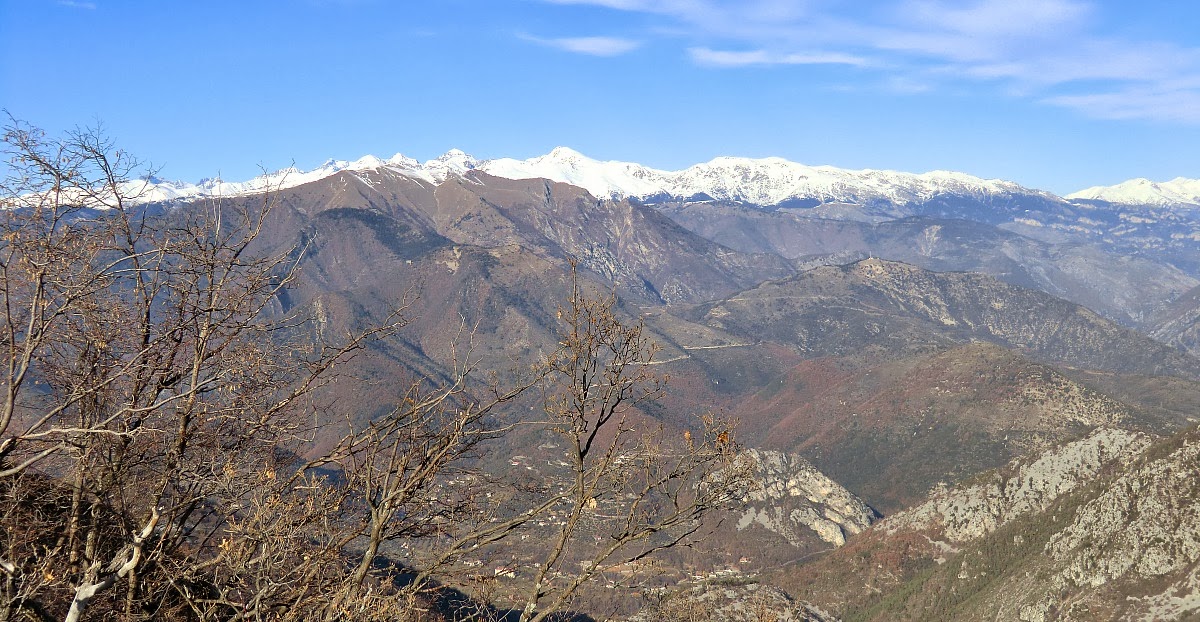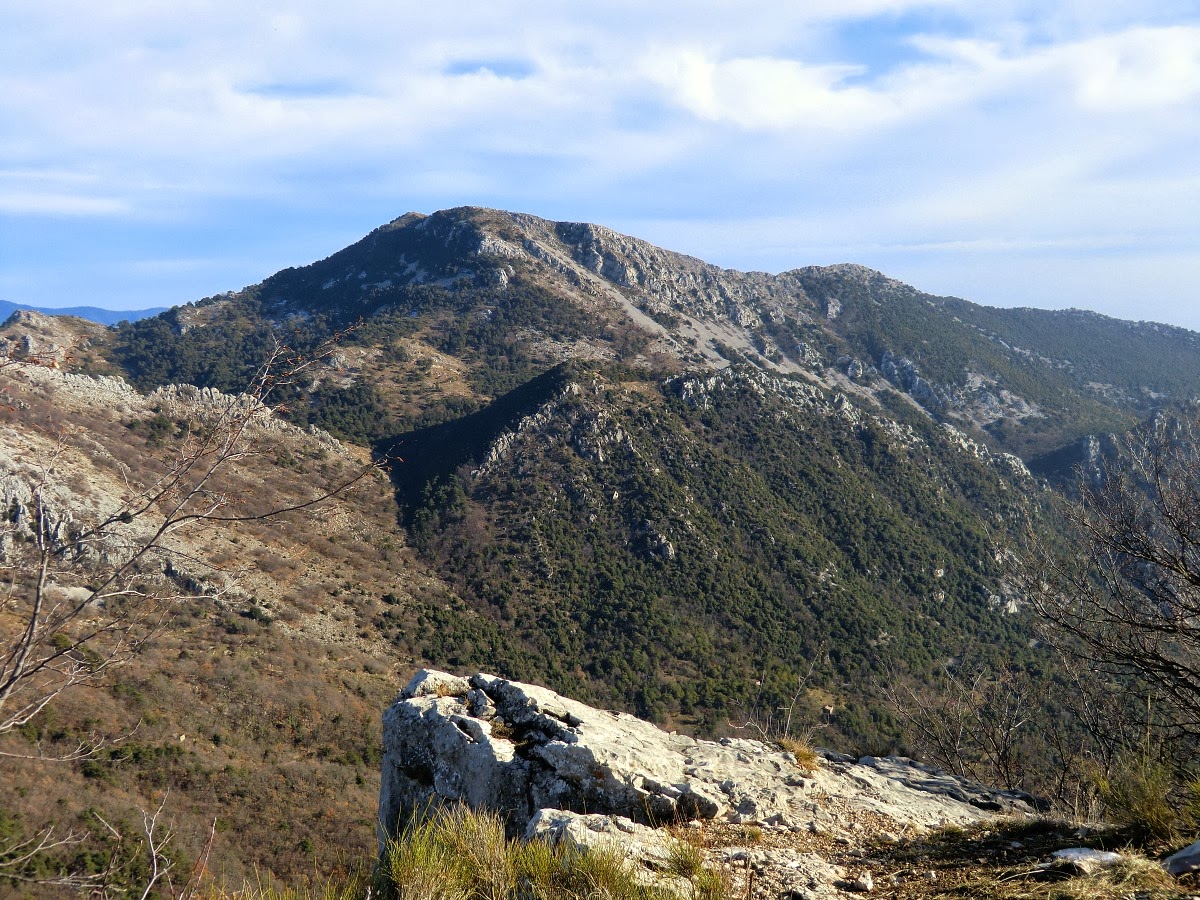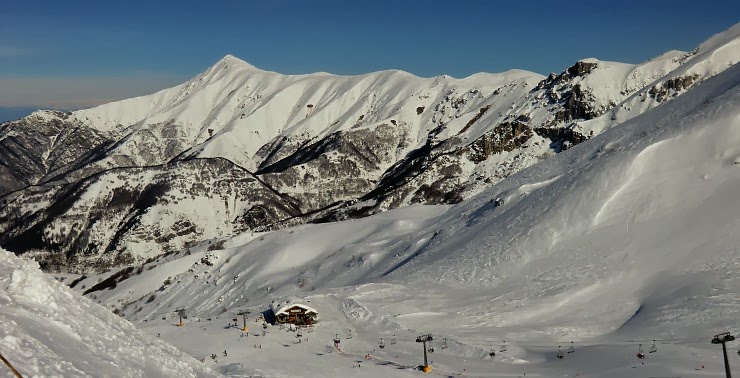
Duck breasts, magrets de canard or simply just magrets, are popular in France. The dark and strong flesh of duck goes very well with sweeter sauces and fruit; duck with orange is a classic combination.
I have always found pan-frying duck breasts and pouring away the hot fat halfway in the cooking a bit complicated method, at least if you are cooking for four or six people. So I was eager to try oven roasting them as was recommended on the package. It turned out so well that I am going to use this method more often.
The orange sauce in this recipe is my favourite variation. I like to serve duck breasts simply with new potatoes and some vegetables. Steamed broccoli florets or Brussels sprouts are nice in this recipe.
4 servings
2 duck breasts, magrets
2 oranges, pressed into juice
4 tsp good orange marmalade, such as Florian confiture d’orange
2 tsp red wine vinegar
Black pepper, freshly ground
Fresh thyme leaves
2 tsp corn flour diluted in a small amount of water
Preheat the oven to 200 ⁰ C.
Line a large baking tray with baking paper. Choose a tray with walls because the duck breasts give away quite a lot of hot fat. The fat solidifies eventually and is easier to discard the next day.
Criss-cross the fatty skin of the duck breasts. Place them in the baking tray flesh-side down. Roast in oven for 15 minutes, then turn and continue cooking a further 15 minutes, skin-side down this time. Remove the breasts from the baking tray and place them on a carving plate. Keep them warm under foil and slice after a while.
Meanwhile cook the sauce. Press the oranges and simmer the juice in a small casserole. Whisk in the marmalade and red wine vinegar. Add some thyme leaves, save the rest for the decoration, and grind in some black pepper. Whisk the corn flour in a small amount of water until smooth. Use it to thicken the sauce as needed; you may not need to use it all.
Divide the sauce on the plates and place the duck breast slices on the sauce. Divide the new potatoes and vegetables on the plates and decorate with thyme leaves.
On doit profiter…you have to grab the opportunity as the spring has finally arrived on the French Riviera after a very wet winter. Even the previous record from 1978 was beaten.
The hike to Mont Chauve starts from the charming and well-kept village of Aspremont 14 km north of Nice. Aspremont (500 m) itself offers already great views as it towers high over the Var river valley. There are a couple of restaurants and a bar/café in the centre. The village has recently renovated its parking which is now quite spacious in two floors in the centre of the village.
Mont Chauve (853 m) is located southeast of Aspremont. It is topped by a fortress, and from there you have a panoramic view of Nice, the Baie des Anges, and even some of the boulevards. The strange looking round horizontal thing built on the fortress is a VOR/DME device, a navigational aid for air traffic. In addition, there are a lot of telecommunications masts. Hence, it’s not one of the most beautiful mountaintops per se.
The first signpost is almost next to the parking area. The trail initially follows the D14 road, crosses it and continues along a small road 300m before turning right following the GR5 trail. Ascending along the western hillside of Mont Chauve, one has soon unobstructed views of the Var river valley, Cap Antibes and beyond as well as the snow capped mountains in the north. To ascend the summit, one has to leave GR 5 and turn left at the main intersection south of the mountain, and then follow the trail up to a paved road that leads to the fortress. To complete the hike, as described in the guidebook, the trail back marked by yellow signs descends along the eastern hillside to a place called Baisse de Guigo (730 m) and then straight back to Aspremont.
Map: 3742 OT Nice Menton. Duration of the hike is about three hours. Vertical climb 460 m.
Recommended guide (in French; also on their web site): Tour du Mont Chauve in Rando Pays Côtier booklet.
This recipe is inspired by a Sunday lunch that we had in a bistro in Biot many years ago. I can`t remember the name of the bistro, and it might not even exist any longer. It was a clear, cold winter day, the bistro was full and everybody was truly enjoying the tasty but simple menu.
In those days they served a very reasonable Sunday formule, fixed menu. We managed somehow to squeeze in. This was simple bistro food at its best in a great atmosphere, and I have ever since tried to emulate their basil filled chicken breast with mushrooms.
After seeing a French TV- program recently, I nowadays always buy farm-raised chicken, poulet fermier, and when possible Label Rouge. Label Rouge chickens are most closely controlled. They are out every day, rain or sunshine, picking grass. They are taken in for the night and fed a special corn mixture which is fortified with vitamins and minerals. These sturdy and fit birds live like the chickens were meant to live, so they are normally very healthy. Their meat is firm and tasty.
The basil pure, Le Basilic du Provencal, is sold in glass jars in Nice supermarkets. It is made of crushed basil, olive oil and salt.
2 servings
2 poulet fermier chicken breasts, pref. Label Rouge
2 heaped tsp basil pure, Le Basilic du Provence
2 shallots, minced
2 cloves garlic, minced
4 large mushrooms, halved and sliced
2 tbsp rapeseed oil
50 ml white wine
50 ml chicken stock
2 tbsp crème fraîche, 15 % fat
Freshly ground black pepper
Parsley to decorate
For the side dish of roasted tomatoes:
1 tomato, halved
2 tsp bread crumbs
2 tsp olive oil
Freshly ground black pepper
A pinch of salt (optional)
With a small sharp knife, cut the pockets in chicken breasts and fill with basil pure. Over medium heat, warm 1 tbsp rapeseed oil in a large heavy pan. Fry the chicken breasts on both sides until golden brown. Reduce the heat a little, add the shallots and 1 clove minced garlic in the pan and continue cooking for a few minutes. Add the white wine, chicken stock and black pepper in the pan. Cover and simmer for about 20 minutes.
Meanwhile fry the mushrooms in rapeseed oil with 1 minced clove garlic in a separate frying pan. They need to be fried until well browned on both sides. Then arrange them on top of the chicken breasts.
Roast the tomato halves in 210⁰ C for about 10- 15 minutes until nicely coloured.
Divide the chicken breasts, mushrooms, tomato halves and the sauce on the plates. Decorate with parsley and serve with brown rice.
Have you been thinking about climbing one of the higher peaks in Alpes Maritimes next summer? Consider Mont Pépoiri as a starter. You don’t have to be a superman or woman to ascend this peak. In fact, the vertical ascent is only about 650 m as you can drive up to 2030 m to Millefonts. On the other hand, if you really want to do it the hard way, start your hike down in the valley! The road up to Millefonts starts from St-Dalmas-Valdeblore, distance from Nice is 77 km.
The great hike presented in this video clip is well described in French in the Conseil Général Guidebook “Haut Pays” and is called “Traversée du Pépoiri”. On their web site, you can click "visualiser la carte" to see the trail. From the summit, you can take the same route back or alternatively -as the guide describes- the hors-sentier route back via Lac d’En Veillos. We recommend the latter in good weather and visibility. The initial ascent from Millefonts is along GR 52 passing the lakes Lac Petit (actually the biggest!), Lac Long and Lac Gros. From signpost 84 onwards, the route is marked with cairns. The summit with its mast is soon visible. As the video clip shows, all the major peaks of Mercantour National Park and beyond are visible from this altitude.
Having done this first, one can start planning climbing Cime du Diable and Mont Mounier (seen also from distance in this video clip)!
I have previously posted my best rabbit recipe in which rabbit, tomatoes, fresh basil and black olives make a truly tasty combination. But how to prepare rabbit in winter, when even on the Riviera tinned tomatoes often are a better choice than pale and watery winter tomatoes and locals choose pistou instead of fresh basil? Pistou is crushed basil, salt and olive oil and it is an ancient preservation method in the South of France.
Rabbit goes very well with white wine, crème fraîche, mustard and black olives. I have seen many winter rabbit recipes using these ingredients, and rabbit made like this is often served in restaurants in the South of France. The following recipe is my best winter rabbit.
Bouquet garni is a bundle of herbs usually tied together and mainly used to prepare soups, stocks and stews. Ducros bouquet garni is made of various vegetables and aromatic herbs and is available in small individual packets.
2 servings
2 rabbit legs, cuisses de lapin
2 tbsp rapeseed oil
3 shallots, peeled and cut into quarters
1 garlic, minced
1 sachet Ducros bouquet garni
100 ml white wine
2 tbsp crème fraîche, 15 % fat
1 tbsp grainy mustard, moutarde à l’ancienne
About 10 black olives
Black pepper, freshly ground
Parsley, minced
Warm the rapeseed oil in a heavy casserole over medium heat. Fry the rabbit legs on both sides until golden brown.
Add the shallots, garlic, black pepper, bouquet garni and white wine to the casserole. Reduce the heat and simmer, covered, for about an hour. Turn the rabbit legs a few times.
When only about 10 minutes of cooking time remains, mix the crème fraîche with mustard and add to the casserole with the black olives.
Decorate with parsley and serve with new potatoes and green beans.
The little village of Castillon between Menton and Sospel has had a troubled history. It was first created in the 12th century when fortifications were built on the site –hence the original name “Castiglione” or a small castle.
In 1887 an earthquake with its epicenter somewhere near the Ligurian coast left the village in ruins. It was rebuilt, but in 1944 during the final phases of WW II the village was again destroyed by the Allied bombardment. At this moment the village was still occupied by Germans. Military installations (See: Ouvrage Castillon; in English) had been built here in the 30's as part of the little Maginot line.
For the rebuilding, another site was chosen a bit further down the valley for the current village of Castillon (550 m).
For hikers, the site of the ancient village at Col de Castillon (730 m) is an ideal starting point as it happens to be in the crossroads of many marked trails. Here, the ruins of the church still remain.
The hike presented here can also be found in the Conseil Général guidebook “Pays Côtier” (in French) where the hike is called Circuit du Razet and graded as medium/moyenne. The vertical climb is about 500 m, about 100 m more if you visit the mountain top at 1285 m (recommended). Needless to say, views from there are great. As always, it’s recommended to have the topographic map of the area as well. (IGN 3741 ET) From the starting point at 730 m, you first walk straight north along a small road, reaching signposts 136 and 137, then further 92 and 93. From the latter, it’s a short walk to a place called la Pierre Pointue (1176m) –also the site of an old military outpost. Many old bunkers can be seen here. From here, the peak can be reached in 15 min. The route back to the starting point goes first to signpost 93 then turns left and descends eventually to nr 137. It’s marked with yellow signs all the way.
Apart from rewarding views both to Mercantour national park and its peaks, and the bay of Menton in the south, the hike offers some insight to the quite turbulent history of the region. When driving there from Menton, remember to exit the D 2566 road just before the tunnel which actually goes under the Col de Castillon.
Fresh cod, cabillaud, has a mild flavour and a dense, flaky white flesh. It should be cooked al dente, just cooked, but never over-cooked. Cod goes very well with mild vegetables, such as carrots, leeks, courgettes and potatoes.
In France, the traditional fresh cod season used to be from March to May, and salt cod, morue, was consumed at other times. Nowadays fresh cod is available year round in supermarkets as the farmed fish and seafood have become more popular.
The following recipe is a carefree one-pot dish. A heavy casserole, such as Le Creuset, is best for this recipe.
2 servings
2 fresh cod fillets, about 150- 200 g each
1 carrot, sliced
2 small courgettes, sliced
1 leek, sliced
4 new potatoes, sliced
½ fennel, sliced
1 clove garlic, minced
2 tbsp rapeseed oil
Black pepper
Parsley, minced (try dill or chives for a change)
100 ml fish stock (made with 100 ml water and 1 heaped tsp Ducros fumet de poisson)
50 ml white wine
2 tbsp crème fraîche, 15 % fat
Slice the carrots, potatoes and fennel. Warm the rapeseed oil in a heavy casserole over a medium-low heat and sauté the vegetables for about 10 minutes stirring occasionally. Add the white wine and continue cooking for about 15 minutes until the vegetables are almost cooked.
Make the fish stock by whisking 1 heaped tsp fumet in 100 ml hot water. Slice the courgettes and leek and add to the casserole. Mince the garlic and add to the casserole together with the fish stock. Bring to a boil, and then reduce the heat to simmering. Add the crème fraîche and stir.
Place the cod fillets on top of the vegetables. Grind a few rounds of black pepper over the fish and cook under cover for about 15 minutes until the cod is opaque and just cooked.
Decorate with fresh herbs and serve.
Studying the ski map of Limone Piemonte (1010 m), one might first get the impression of a pretty small winter resort just 44 km from the Mediterranean. In addition, the highest lift reaches “only” 2085 m…how long is their season?
Having visited Limone several times before, we knew the reality is very different. Limone is one of the oldest winter sports resorts in Italy. They have a history of over 100 years. The runs are long and usually well maintained. The biggest continuous vertical descent is 1000 m, actually more than Auron and Isola 2000 nearby in France can offer. Maybe it’s the geography combined with meteorological facts that result in more snowfall. The cold northerly winds blowing over the Italian plain nearby meet the warmer and the more humid Mediterranean air here. The latest snow depth on their web site reported 350 cm on the top, 250 cm in the valley, avalanche risk 3/5.
Recent recurrent traffic problems in the Tinée valley have certainly turned the eyes to Limone. The Roya valley is by no means immune to traffic problems either. But from Limone you have at least the long “escape” route back to the coast via Italy. The driving time from Nice is about two hours. The recommended route from Nice is to take the A8 to Ventimiglia, then north along S20 and further along D6204 to the tunnel at Col de Tende. Check the inforoutes06 web site the morning you leave!
You don’t have to drive all the way down to the town of Limone if you’re on a day trip. Immediately after the tunnel on the Italian side, you can take
the small road left to reach Limone 1400.
Its lift system is connected with the rest of the resort.
The only way to reach the skiing area from the town is to use the gondola called Severino Bottero. It’s newish and fast but queues tend to build up here, especially in front the ticket booths. On the day of our visit, we had just managed to buy our ski passes when the gondola stopped. There were a lot people waiting and waiting. No information was given. Eventually we came back one hour later. It turned out that the wind speed had increased to a level that they had to close all lifts for the rest of the day. No cash refund was offered. They gave receipts that could be used for ski passes the next day or later this season.
Valentine’s Day started with clear skies and light winds. After some queuing again, yesterday’s purchases were refunded and up we went! No queues whatsoever here. The only limit was your performance. There are several great red runs, all well groomed so watch your speed! The black run number 16 called Olimpico Giacomo Marro back to the gondola station is very good as well, might be classified red somewhere else.
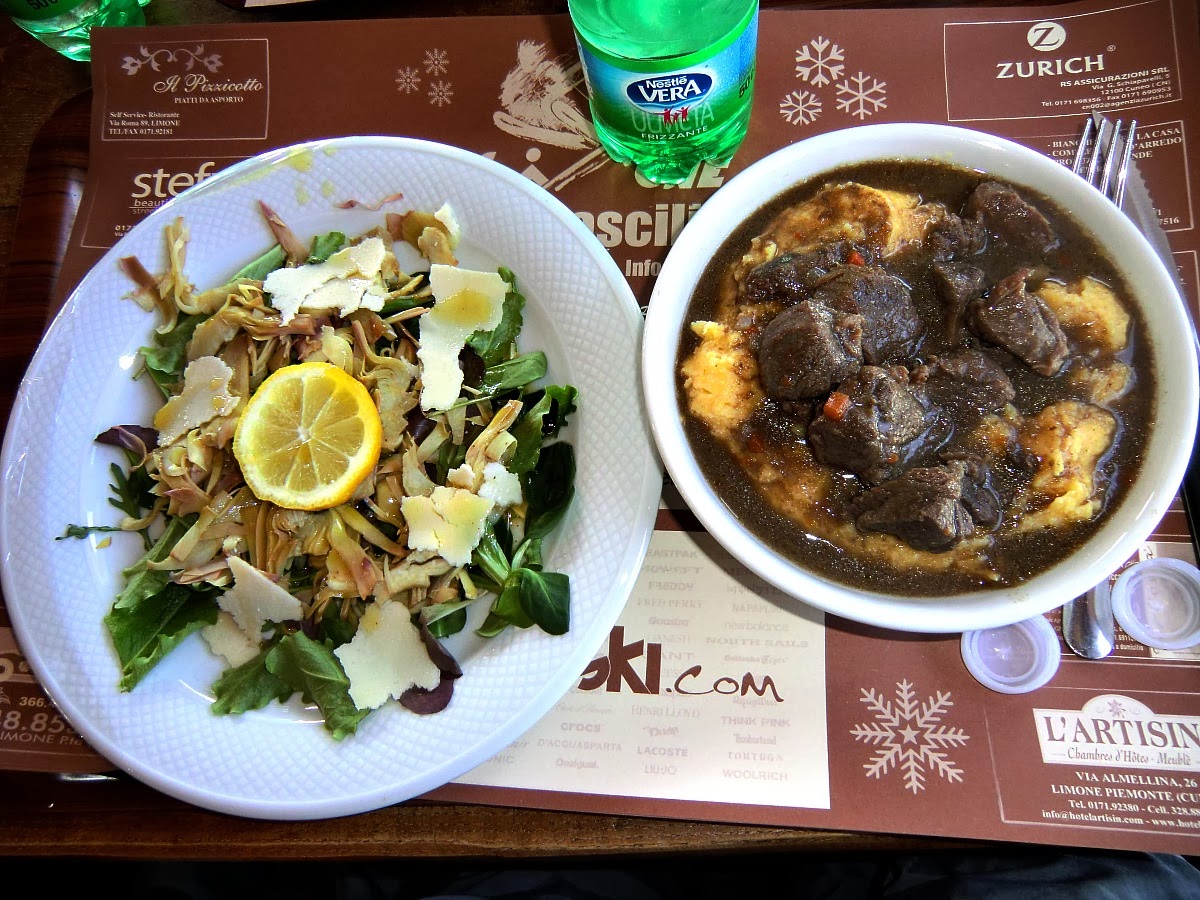 When in Italy, you ski and eat with style. We went to our favorite high altitude restaurant. We opted for salad with parmesan and artichokes followed by wild boar in red wine sauce with polenta. Gustoso! Not bad at 1800 m. Furthermore, we stayed overnight at Grand Hotel Principe next to the gondola station. They too serve traditional Italian cuisine, as it used to be in the old days. Fresh ingredients, no nonsense, not Michelin but tasty! Not easy to find in Florence or Rome these days unless you know where to go.
When in Italy, you ski and eat with style. We went to our favorite high altitude restaurant. We opted for salad with parmesan and artichokes followed by wild boar in red wine sauce with polenta. Gustoso! Not bad at 1800 m. Furthermore, we stayed overnight at Grand Hotel Principe next to the gondola station. They too serve traditional Italian cuisine, as it used to be in the old days. Fresh ingredients, no nonsense, not Michelin but tasty! Not easy to find in Florence or Rome these days unless you know where to go.
This is a warming simple dessert for those miserable rainy winter evenings in Nice when I start dreaming about sunny spring days and colourful fresh apricots and peaches. Luckily in winter there seems to be really good imported pineapples in our supermarket.
The warming effect comes from a mixture of spices. Quatre épices is a mixture of ground cinnamon, ginger, clove and nutmeg. It is easy to find in Nice supermarkets, and it is also easy to make your own mixture. The ground spices lose soon their taste and have to be replaced regularly. Some freshly ground black pepper and cumin add to the warming effect of spices.
I like to serve the roasted pineapple with some fresh French cheese, fromage blanc 0 % fat. In spite of being practically fat-free it has a good round taste and compliments well the spicy pineapple. Fromage blanc is a good source of protein and calcium; some are even supplemented with vitamin D, all important nutrients for bone health. You could serve your pineapple with classic mascarpone or vanilla ice cream for a special treat. Even some world famous French chefs nowadays choose healthy ingredients in their Michelin restaurants and consult nutritionists and dietitians.
4 servings
1 pineapple
6 tbsp sugar
1 tsp freshly ground cumin
2 tsp quatre épices
Freshly ground black pepper
Peel the pineapple and remove the tough inner section. Cut into fairly large cubes.
Preheat the oven to 200⁰ C, roast.
Mix the sugar and spices. Roll the pineapple cubes in the mixture and place on an ovenproof dish on single layer. Roast for 20 minutes.
Divide the pineapple cubes on the plates and spoon over any juice from the bottom of the roasting dish. Serve with fromage blanc, mascarpone or vanilla ice cream.
We remember learning at school that Mediterranean winters typically are mild and rainy. This winter certainly fits the description, at least as far as the rainy part goes. You have to grab every opportunity even for short hikes and walks!
At 222 m, Mont Alban situated between Villefranche-sur-Mer and Nice is not really a mountain. The visitor is nevertheless awarded by great views as the video clip shows. The walk presented here is also called Circuit du Mont Alban. It is well described (in French) and recommended in the randoxygène guidebook.
This is a walk that combines culture, history and nature. You can even explore the outdoor market in Villefranche. The walk starts with a long ascent along stairs (l’escalier Campo Quadro) gradually reaching the middle Corniche. From this point, it is about 500 m to col de Villefranche. The trail (marked with yellow) then continues to Mont Alban and the fortress. Built in the mid 16th century by the Duke of Savoy Emmanuel Philibert, the fort is today normally closed. Guided tours have been arranged during the summer. From here, the trail continues south about 500 m, then turns left and descends trough a wood back to the basse Corniche and finally down to the port of Villefranche.










